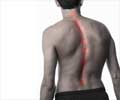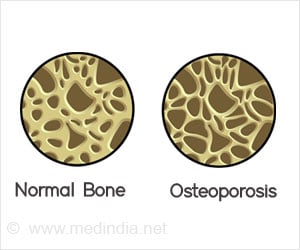A review of published research has concluded that the use of braces to correct excessive curvature of the spine, or scoliosis, in adolescents is still an area of controversy
A review of published research has concluded that the use of braces to correct excessive curvature of the spine, or scoliosis, in adolescents is still an area of controversy - and is likely to remain that way until there is better evidence.
Although some evidence points toward a benefit from using braces, research has failed to prove definitively that they work. Adolescent idiopathic scoliosis - curvature of the spine in which the cause is unknown -affects about 1 percent to 12 percent of the general population. Scoliosis is much more common in girls and is more likely to be severe in girls. About 10 percent of children and teenagers who have scoliosis will require treatment, based on the severity of the spinal curvature. Others can have monitoring without treatment to see if the spinal curve worsens. In severe scoliosis that remains untreated, lung, heart and spine damage might occur in adulthood. "Bracing is regarded as effective by some and as useless by others," says Stefano Negrini, M.D., lead author of the review. Negrini is the scientific director of the ISICO (Italian Scientific Spine Institute) in Milan. A variety of braces is used to slow the worsening of spinal curvature in adolescent scoliosis. Originally, braces were made from rigid metal, but most now are made from lightweight molded plastic. Still, such treatment can profoundly affect a teenager''s life. Braces, which often must be worn 16 to 20 hours a day, can cause decreased ability to move, sleep disturbances, poor body image, emotional problems and social difficulties. Some health care providers say bracing is no more effective than the "wait-and-see" approach.However, if a patient''s scoliosis worsens, surgical fusion of the spine using rods might be the only alternative, a procedure that can cause potentially serious side effects, such as nerve damage and loss of mobility. The review appears in the latest issue of The Cochrane Library, a publication of the Cochrane Collaboration, an international organization that evaluates medical research. Systematic reviews draw evidence-based conclusions about medical practice after considering both the content and quality of existing medical trials on a topic.
Although there are many studies on bracing in scoliosis, Negrini and colleagues found only two studies that actually enrolled participants into different treatment groups and then compared how they did. This is because designing this type of study - called a randomized controlled trial - to test bracing in scoliosis is no easy undertaking. "Bracing is a very long-term treatment," Negrini said. "Moreover a complete committed team made up of physicians, orthotist [a person who fits braces], physiotherapist, parents and the patient is required." Researchers found that in one study of 286 girls, braces slowed worsening of the scoliosis in 74 percent of participants, compared with about 33 percent in groups that did not receive treatment or underwent electrical stimulation. A second study of 48 girls, found that a rigid brace slowed scoliosis more than an elastic one did. "The studies included in the review are not able to provide strong evidence," that will affect how scoliosis is treated, Negrini concluded. Despite this lack of evidence, Negrini said his clinic frequently prescribes braces in conjunction with exercises for patients with scoliosis. Teamwork with orthotists and physiotherapists is key, he said.
"We are aware of the very good results it is possible to obtain with high-quality bracing and making sure there is good patient compliance with wearing the brace," Negrini said. "For us, the ‘wait and see'' option is not a possibility." Avoiding any eventual need for spinal fusion is the goal. "Just one patient not fused is worth all our clinical efforts," he said. John Dormans, M.D., chief of orthopedic surgery at the Children''s Hospital of Philadelphia and president of the Pediatric Orthopedic Society of North America, shares a similar attitude toward bracing.
"If you ask a skydiver if a parachute works, there''s no randomized controlled study, but they know from experience it works," Dormans said. "If you polled the orthopedists who treat the vast majority of patients with adolescent idiopathic scoliosis, the overwhelming opinion would be that bracing is effective, that it does alter the natural history of the disease." However, getting teenagers to actually wear braces is another issue, Dormans added. "There are studies that show big discrepancies between how many hours patients say they are wearing the brace and the hours the actually wear them." Questions about the effectiveness of bracing in adolescent idiopathic scoliosis might soon be answered by more definitive research: a five-year, multimillion-dollar study funded by the National Institute of Arthritis and Musculoskeletal and Skin Diseases is currently under way.
The Cochrane Library (www.thecochranelibrary.com) contains high quality health care information, including Systematic Reviews from The Cochrane Collaboration. These reviews bring together research on the effects of health care and are considered the gold standard for determining the relative effectiveness of different interventions. The Cochrane Collaboration is an international nonprofit, independent organization that produces and disseminates systematic reviews of health care interventions and promotes the search for evidence in the form of clinical trials and other studies of interventions. Visit www.cochrane.org for more information.
Advertisement
Source-Newswise
RAS










